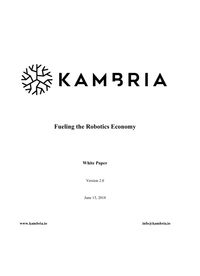
1. Introduction
1.1. Shortfalls of Modern Robotics
Within just a few decades of Alan Turing proposing the question: “Can machines think?”i and Joseph
Engelberger developing the first robot prototype, robotic machines were adopted on a massive scale in the
industrial work space.ii Robotic arms can be found on many assembly lines, from manufacturing
automobiles to preparing meals. The revolution of industrial robots was fueled by advancement in
computing power and artificial intelligence. The former allowed robots to be programmed. The latter gave
robots complex reasoning ability. More recently, robots have employed sensors to interact with the real
world to handle a wide range of tasks. [Large economic value, captured by specialty machines working
around the clock, hastened the use of robotics on all manufacturing lines.iii]
Although robots have succeeded in finding their place in manufacturing, they have not yet been widely
adopted in the home. After more than half a century of research, progress has been slow in making
affordable robots that can address our everyday needs in the home. Traditional development processes
used by robotics companies result in high cost production, which is not effective for the everyday
consumer market. Only robots programmed to do very simple household tasks, such as vacuuming or
mowing, were able to capitalize on the small profit margins resulting from consumer products. Highly
functional robots, including the Honda Asimoiv that can walk up the stairs and Toyota’s Human Support
Robotv that can fetch, are limited to research facilities due to their expensive price tags. OhmniLabs does
not believe that this will be commercially viable in the near future.
It is clear that the problems robotics engineers struggled with from the beginning of robotic development
are still prevalent today.
#1. Lack of good interfaces and abstraction layers for software, electrical, and
mechanical systems.
• Leads to bias towards monolithic and non-modular designs
• Results in a requirement for major redesign effort for any modifications
• Makes the design hard to reuse by others and continues the cycle of waste
• Reduces efficiency since no common point is available for developers to work off in parallel
#2. Lack of tools, semantics, and methods to share parts of designs in distributed fashion.
• Many engineering domains involved in robot design (mechanical, electrical, etc.) lack good tools for
collaboration and sharing
• Missing semantic linkages across systems, including software design to electrical engineering, and
electrical engineering to mechanical engineering
• Currently, the development materials are a chaotic tangle of repos, directories, sheets of BOM
parts, text assembly instructions, slicer settings, and supplier names in scattered local servers
and cloud storages
#3. Significant portions of expended effort are
implicitly discarded.
• Duplicated effort by robotic manufacturers to find good
suppliers, select parts, negotiate terms, verify paperwork,
and assemble an in-house team
• Very few practical standards or instructions to capture the
comprehensive start-to-end process information
#4. Robotic applications are slow, expensive, and hard to make. Innovation is slowed.
• Inadequate infrastructure and high-level abstractions for robot programming
• Lack of open platform and development tools accelerate innovation
• Most explorative development is bootstrapped and not supported
• Capital funding is only offered to large scale or mature projects
#5. Slow turnaround, high minimums, and poor interfaces from "traditional"
manufacturers.
• These design problems significantly slow development speed
• They are bottlenecks in the design/build/test cycle
• They result in higher costs, time, and effort
Due to these challenges, the current pace of robotics innovation is needlessly slowed. The purpose of the
Kambria platform for open innovation in robotics is to free the robotics industry from these impediments
and accelerate the evolution of robotics technologies. Our founders believe that the future is too important
to be controlled by a select few entities and the ethical responsibility of the robotics community is to
ensure that the development of robots will be more equitable and utilitarian. The robotics community
must find ways to collectively govern, and benefit from the coming revolution in robotics.




